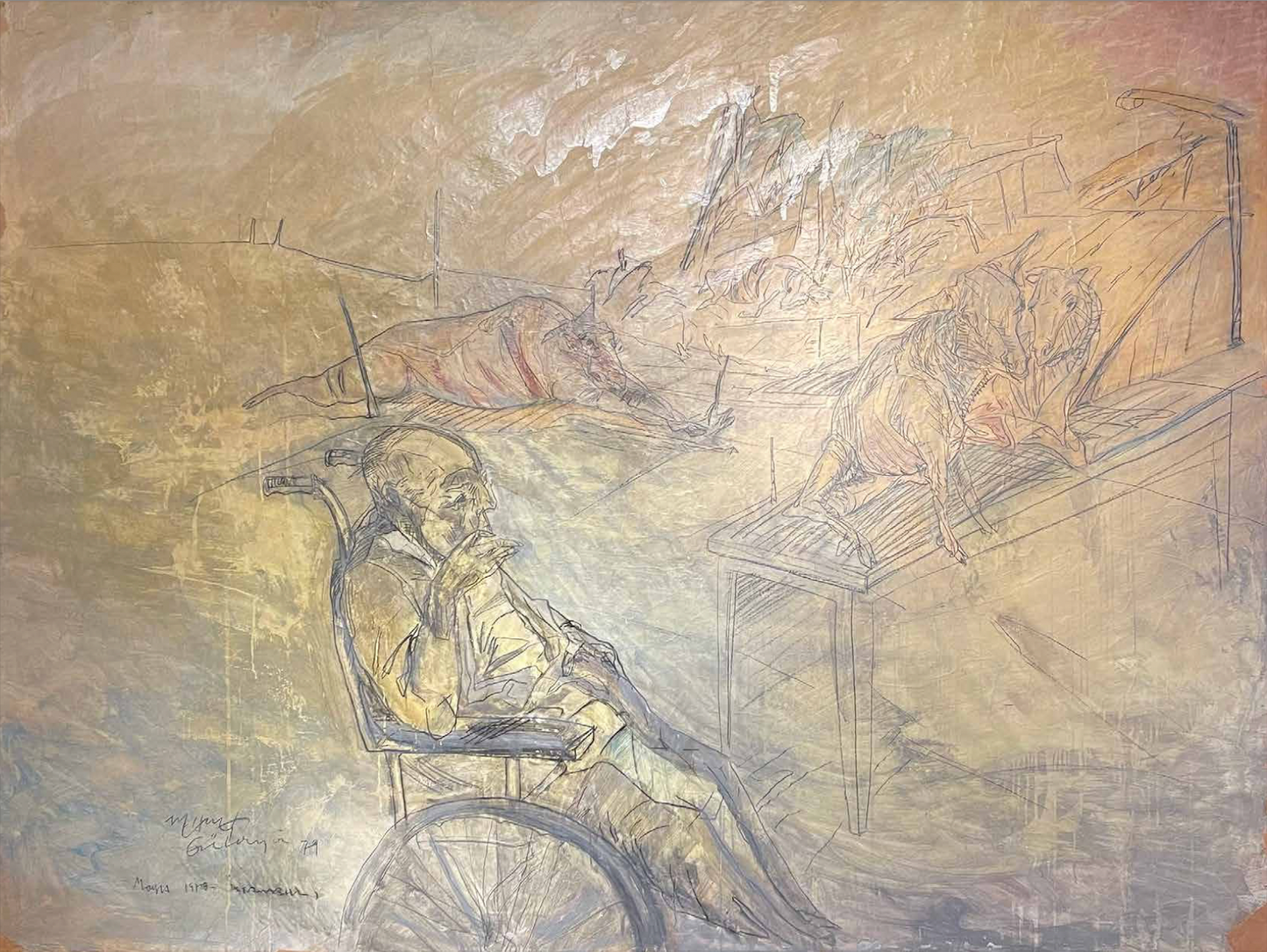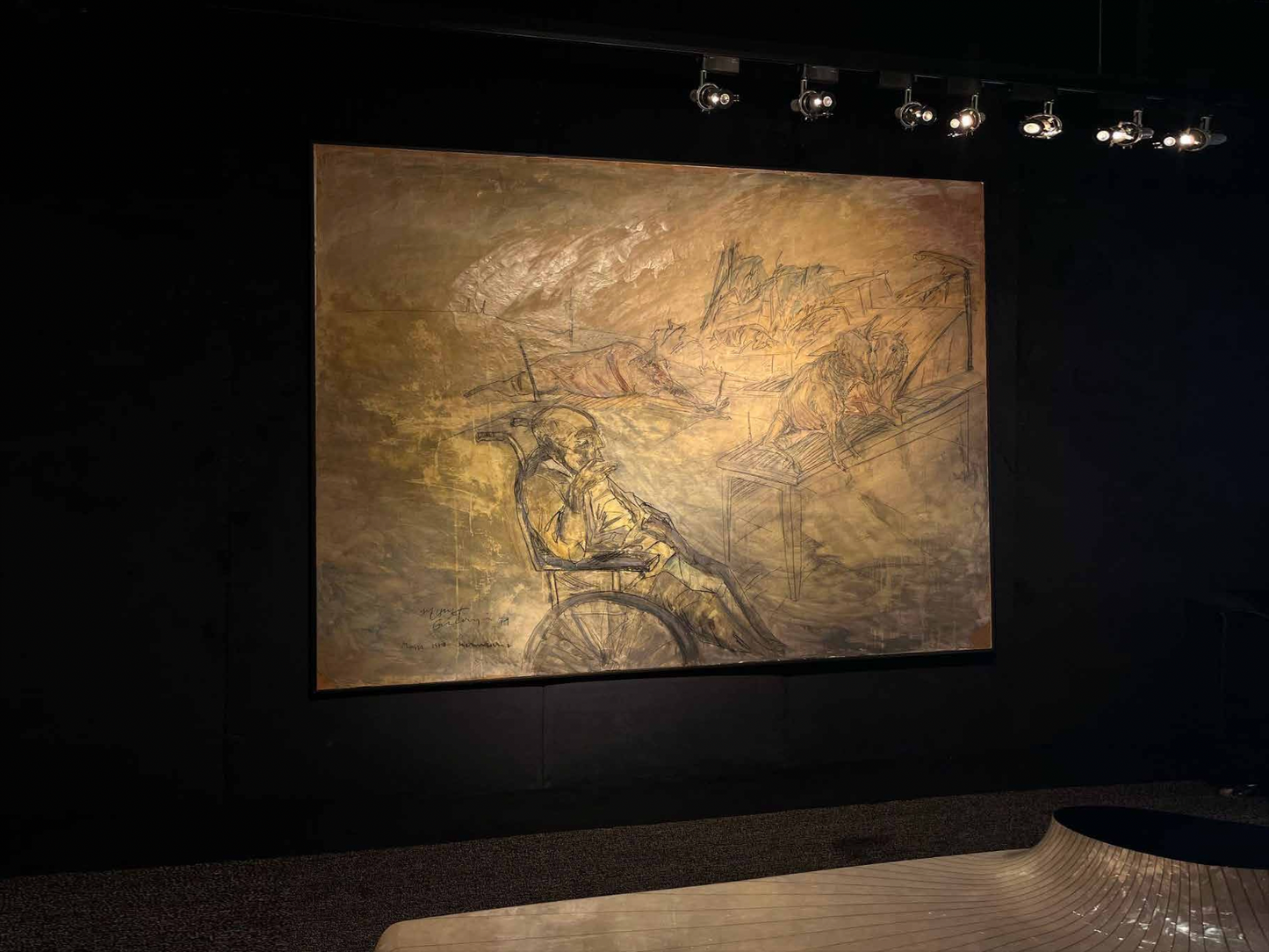MEHMET GÜLERYÜZ - DEPRESSED
MEHMET GÜLERYÜZ - DEPRESSED
MEHMET GÜLERYÜZ 1938-2024
Depressed
Signed, dated 1979
Oil on paper, placed on canvas
200 x 250 cm
Price is available upon request.
Provenance
Private Collection, Istanbul Artist Collection
Exhibition
Istanbul Modern Art Museum Painter and Painting
Mehmet Güleryüz Retrospective 8 January - 28 June 2015
Literature
Istanbul Modern Art Museum
Painter and Painting
Mehmet Güleryüz Retrospective Catalogue p. 102
"There are three different processes in creating images: Perception, the ''processing'' of what is perceived
placement, processing and transformation. Undoubtedly, we do not know at what point our own body is open and prepared for messages coming from the outside world; but we should also take into account the possibility of perception confusion. Just as our eyes can sort out everything that comes, every contact, as a picture; they can also interpret messages that are far from the picture much later with the help of reasoning and transform them into pictures.
As a result, perception is not only related to an object or an image; it is also related to a situation, an emotion, or even an incidental emotion, a brand new thought that the artist rarely encounters within himself.
"it can be possible; with a new thought that can allow for many openings..."
Istanbul Modern Art Museum, 2015, Painter and Painting
Mehmet Güleryüz Retrospective Catalogue p. 75
MEHMET GÜLERYÜZ
Violence first strikes the viewer on a visual and emotional level. So much so that, as one approaches the canvases, the descriptive and figurative become blurred and the eye only encounters paint. For this reason, these paintings do not convey a message to the viewer.
In other words, one withdraws. With this definition, I think it can be used as an analysable concept of Güleryüz's painting. As a means of staying away from the dramatic effect of the painting, which is both visible and incorporated into the content. Güleryüz certainly likes suggestion, but he also thinks that the alienating element, like Brecht, which he acquired during his theatre experience, can enter the content in the idea of catharsis.
Güleryüz's compositions do not rely on the general Brechtian montage and collage techniques, of course. But he also draws strength from the concept of coincidence rather than the concept of wholeness. He foresees the simultaneous existence of coincidence and secrecy (potentiality). The desire to unmask the geo-spiritual accumulation of humanity, while being monolithic, tiresomely brings the catotic and apocalyptic into play both intellectually and formally/stylistically. Indeed, even in Güleryüz's most cynical and cheerful paintings, a sense of doom is felt. Or, to put it mildly, there is a melancholy.
It can be argued that yellow has a semantic function in his latest paintings, as it did in his previous ones. For example, the tragic effect of the woman waiting on the chair by the telephone stand is not due to the narrative, but to the yellow color that surrounds the composition. Because yellow, when considered in its historical context, is the color of autumn, of drying up, and in a more extreme sense, of death.
Although Güleryüz, including some of his previous canvases (for example, “The Wardrobe” and “The Encounter”, 1985), is in a different form from my interpretation, it can be said that, as Beykal stated, he never tries to surprise the idea or to provide a combination between two artistic methods. Metaphorical description can lead to different problems of interpretation, both from an artistic and ideological/political perspective.
I touched on the importance of coincidence above. For example, as soon as I saw the picture of “Billiard Player”, the question of whether Güleryüz was left-handed or not came to my mind. Because, the player in the picture was using the cue with his left hand. Whether it was done intentionally or unintentionally, the composition of this left-handed form must have been taken.
In this case, Güleryüz says that this was completely coincidental. Yet coincidental has a determining factor: the lamp illuminating the billiard table was also being tilted very slowly to the left, illuminating only the part where the player's arm and hand were located. This arrangement would of course require the exact opposite lighting and figuration in a picture made with the expectation of someone using the cue normally with their right hand.
Although Güleryüz’s paintings have intellectual implications, in the final analysis, they are works that feed on Pathos, not Logos. They seem to clash. His anxiety towards Dada and post-Duchamp movements may stem from a kind of concern for unity. Because the historical avant-garde wanted to fulfill a function of unmasking. Its contemporary versions, on the other hand, stand in a suspicious position, ignoring its ideological burden. In the words of Richter, who was involved in the Dada movement: “Pop-Art is in fact the ideology of our society, not the unmasking of it.”
It is worth recalling that Ortega y Gasset, in 1925, was overcome with discouraged distress at some of the products of the historical avant-garde and wrote, "As long as art is stripped of its touching human content, it remains important art; without any pretense of being humane."
Güleryüz paints with the twisted movement of the arm and hand. He does not look for the subject or meaning, he finds it while doing it. Monstrous figures, deformed bodies, appearances and objects that have lost their naturalness are directly imagined, perhaps invading the canvas surface without deepening from within.
Of course, Güleryüz does not see inner experience only on a personal level. There are of course elements of the oblojoria (outside the frame) of fear, horror and brutality, but there are also elements specific to the social environment. There are also situations of fear and loneliness experienced in public spaces, for example in American bars and restaurants.
Despite living in America, Güleryüz stayed away from Dada and post-Duchamp American versions, especially objectification and spatialization tendencies. It cannot be said that he compromised with the absolute, reductionist approach of Op-Art and Pop-Art. Although he did not disagree with the anti-sensational and limited practices on the “camel” in the Feshane arrangement, the dramatization of art did not interest him much. He did not insist on such aggressive attitudes belonging to the world of show business. Güleryüz always remained loyal to peinture. We can say that he did not break away from human and ethical problems and did not aim to exclude them.
In this respect, it can be argued that there is an original connection with the works of the German Expressionists, which have political implications but are also open to ambiguity. It can be said that his painting tries to fulfill the "unmasking" task that Nietzsche assigned to philosophy on a pictorial level.
P Magazine , Issue 3, 1996 A Painter
Ahmet Oktay
Share




